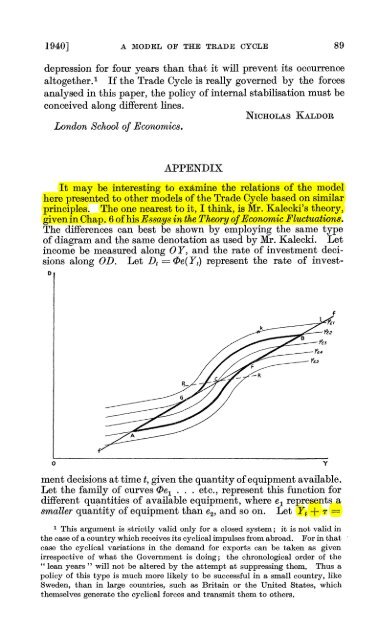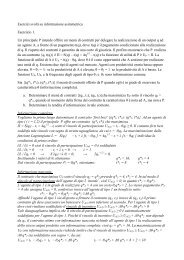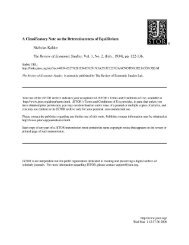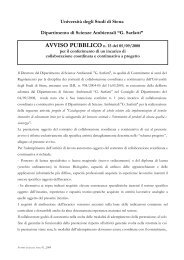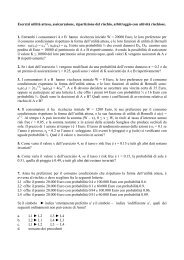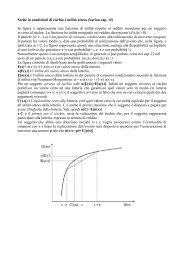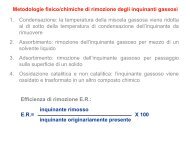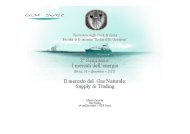88 TRE ECONOMIC JOURNAL [MAROHVariations in <strong>the</strong> amplitude <strong>of</strong> successive cycles, 011 <strong>the</strong> o<strong>the</strong>rhand, seem to depend entirely on extraneous factors, such as newillventions or secular changes ·in habits <strong>of</strong> saving. <strong>The</strong>re appearsto be no necessary reason why, in <strong>the</strong> absen.ce <strong>of</strong> such factors, tlleamplitude should be gradually decreasing or vice-versa.!lO. Our model should also enable us to throw some light onproblems <strong>of</strong> economic policy. Rere I confine myself to twopoints. (i) It appears that measures taken to combat <strong>the</strong>depression (through public investment) have much more chance<strong>of</strong> success if taken at a relatively early stage, or at a relatively latestage, than at <strong>the</strong> bottom <strong>of</strong> <strong>the</strong> depressione If taken early, <strong>the</strong>problem is merely to prevent that graduaI fall in <strong>the</strong> investmentfunction relatively to <strong>the</strong> saving function which carries <strong>the</strong> cyclefrom Stage II to Stage III. But, once Stage III is passed, nothingcan prevent <strong>the</strong> switch-over from <strong>the</strong> B-equilibrium to <strong>the</strong> Aequilibrium, and <strong>the</strong>n <strong>the</strong> problenl becomes one <strong>of</strong> raising <strong>the</strong>investment demand schedule sufficiently to lift <strong>the</strong> position toStage VI (at which <strong>the</strong> forces <strong>of</strong> expansion come into operation).<strong>The</strong> amount <strong>of</strong> public investment required to achieve this isobviously much greater in <strong>the</strong> early phase <strong>of</strong> <strong>the</strong> depression (atStage IV) than in <strong>the</strong> later phase (at Stage V). Thus just when<strong>the</strong> depression is at its worst <strong>the</strong> difficulty <strong>of</strong> overcoming it is <strong>the</strong>greatest. (ii) <strong>The</strong> chances <strong>of</strong> "evening out" fiuctuations by" anti-cyclical " public investment appear to be remote. For if<strong>the</strong> policy is successful in preventing <strong>the</strong> downward cumulativemovement, it will also succeed in keeping <strong>the</strong> level <strong>of</strong> privateinvestment high; and for this very reason <strong>the</strong> forces making fora down-turn will continue to accumulate, thu;s making <strong>the</strong> needfor continued public investment greater. Thus, if, on <strong>the</strong> basis<strong>of</strong> past experience, <strong>the</strong> Government <strong>Author</strong>ity contemplates afour years public investment pIan, in <strong>the</strong> beliefthat <strong>the</strong>reby it canbridge <strong>the</strong> gap between one prosperity-period and <strong>the</strong> ne~t, it ismore likely that it might succeed in postponing <strong>the</strong> onset <strong>of</strong> <strong>the</strong>1 At first sight one might think that this question aiso depends on endogenousfactors: that <strong>the</strong> cycle will be "damped" (amplitude <strong>of</strong> successive cyclesdecreasing) if <strong>the</strong> point <strong>of</strong> zero net investment is so situated that <strong>the</strong>re will be netcapitaI accumulation over <strong>the</strong> cycle as a whole, and vice versa. But this is notso. If <strong>the</strong>re is net accumulation over <strong>the</strong> cycle as a whole (i.e., <strong>the</strong> accumulationover <strong>the</strong> boom period exceeds <strong>the</strong> decumulation during <strong>the</strong> depression), <strong>the</strong>n, in<strong>the</strong> absence <strong>of</strong> extraneous changes, <strong>the</strong> position B at <strong>the</strong> corresponding stages <strong>of</strong>successive cycles will be situated more and more to <strong>the</strong> Ieft; but <strong>the</strong> position Awill aiso be situated more to <strong>the</strong> Ieft, with <strong>the</strong> result that, though <strong>the</strong>re will be agraduaI fall in <strong>the</strong> average Ievei <strong>of</strong> activity, <strong>the</strong>re need be no decrease in <strong>the</strong>deviations around <strong>the</strong> average. <strong>The</strong> same holds, mutatis mutandis, if <strong>the</strong>re isnet decumulation over <strong>the</strong> cycle as a whole.
1940] A MODEL OF THE TRADE CYCLE 89depression for four years than that it will prevent its occurrencealtoge<strong>the</strong>r. 1 If <strong>the</strong> <strong>Trade</strong> <strong>Cycle</strong> is really governed by <strong>the</strong> forcesanalysed in this paper, <strong>the</strong> policy <strong>of</strong> internaI stabilisation must beconceived along different lines.NICHOLAS KALDORL,ondon School oj Econon~ic8.APPENDIXIt may be interesting to examine <strong>the</strong> relations <strong>of</strong> <strong>the</strong> modelhere presented to o<strong>the</strong>r models <strong>of</strong><strong>the</strong> <strong>Trade</strong> <strong>Cycle</strong> based on sirnilarprinciples. <strong>The</strong> one nearest to it, I think, is Mr. Kalecki's <strong>the</strong>ory,givenin Chap. 6 <strong>of</strong>his Essays in <strong>the</strong> <strong>The</strong>ory ojEconomie Fluctuations.<strong>The</strong> differences can best be shown by employing <strong>the</strong> same type<strong>of</strong> diagram and <strong>the</strong> same denotation as used by Mr. Kalecki. Letincorne be measured along OY, and <strong>the</strong> rate <strong>of</strong> investrnent decisionsalong OD. Let D t == ([Je(Y t ) represent <strong>the</strong> rate <strong>of</strong> investo<strong>of</strong>ment decisions at time t, given <strong>the</strong> quantity <strong>of</strong>equipment available.Let <strong>the</strong> family <strong>of</strong> curves ([Je 1... etc., represent this function fordifferent qu~ntities <strong>of</strong> available equipment, where e 1 represents asmaller quantity <strong>of</strong> equipment than e 2 , and so ono Let Y t + T ==1 This argument is strictly valid only for a closed system; it is not valid in<strong>the</strong> case <strong>of</strong> a country which receives its cyclical impulses from abroad. For in thatcase <strong>the</strong> cyclical variations in <strong>the</strong> demand for exports can be taken as givenirrespective <strong>of</strong> what <strong>the</strong> Govemment is doing; <strong>the</strong> chronological order <strong>of</strong> <strong>the</strong>" lean years " will not be altered by <strong>the</strong> attempt at suppressing <strong>the</strong>m. Thus apolicy <strong>of</strong> this type is much more likely to be successful in a small country, likeSweden, than in large countries, such as Britain or <strong>the</strong> United States, which<strong>the</strong>mselves generate <strong>the</strong> cyclical forces and transmit <strong>the</strong>m to o<strong>the</strong>rs.y


